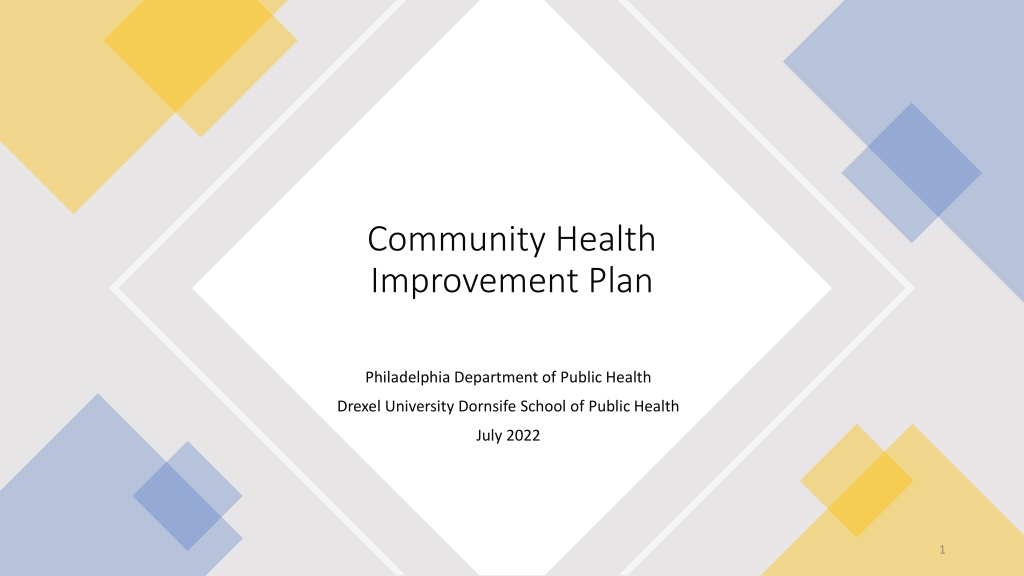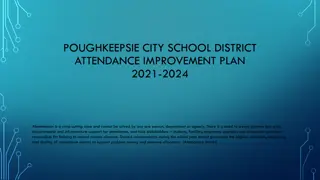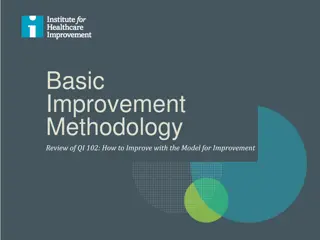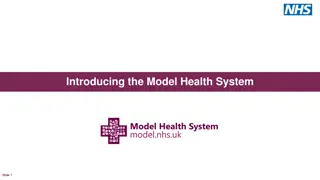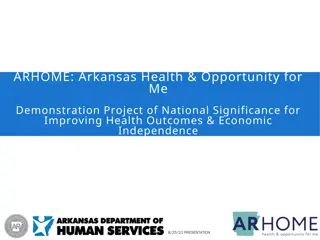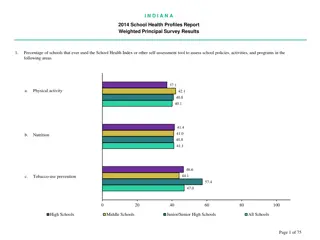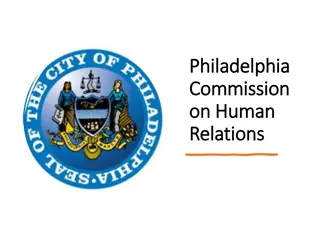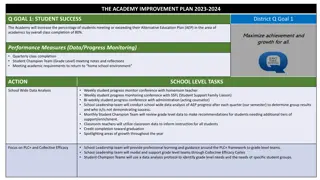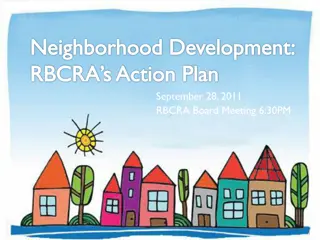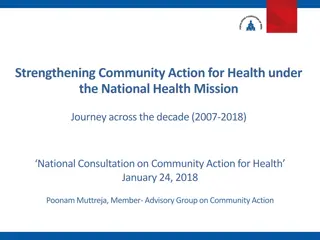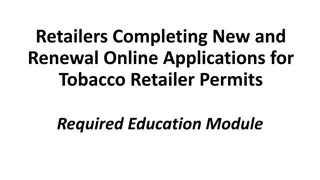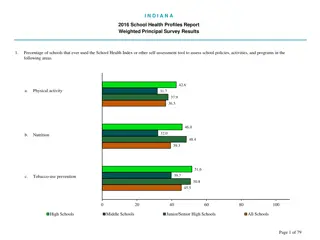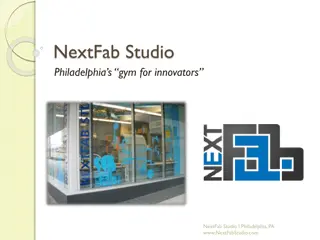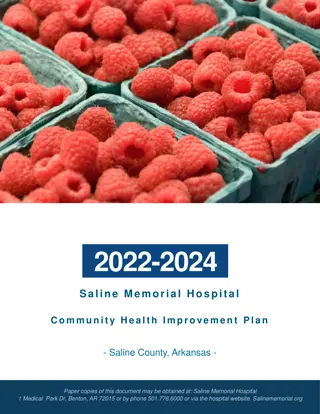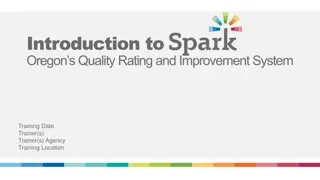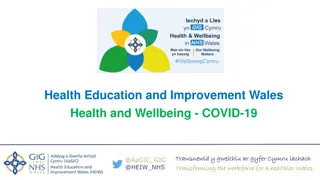Philadelphia Community Health Improvement Plan Overview
The Community Health Improvement Plan (CHIP) for Philadelphia was developed in collaboration between the Philadelphia Department of Public Health and Drexel University's Dornsife School of Public Health. The plan focuses on three key areas: social determinants of community violence, public health preparedness, and access to care/community-clinical linkages. Stakeholder conversations were held to gather feedback and ideas from residents and community-based organizations. Drexel and PDPH partnered to plan, recruit stakeholders, facilitate discussions, and analyze results.
Download Presentation

Please find below an Image/Link to download the presentation.
The content on the website is provided AS IS for your information and personal use only. It may not be sold, licensed, or shared on other websites without obtaining consent from the author. Download presentation by click this link. If you encounter any issues during the download, it is possible that the publisher has removed the file from their server.
E N D
Presentation Transcript
Community Health Improvement Plan Philadelphia Department of Public Health Drexel University Dornsife School of Public Health July 2022 1
CHIP Overview The Community health Improvement plan is a required part of every health departments accreditation to use data and gather community input to guide the priorities of the health department for the next several years This Community Health Improvement Plan (CHIP) was developed in partnership between the Philadelphia Department of Public Health (PDPH) and Drexel University s Dornsife School of Public Health (Drexel) There were three areas of focus for the CHIP, based on prior CHIP priorities and current areas of need and emphasis in Philadelphia: 1. The social determinants of community violence 2. Public health preparedness 3. Access to care/community-clinical linkages 2
CHIP Partners & roles Drexel partnered with the Injury Prevention Program, the Office of Bioterrorism and Public Health Preparedness, and the Division of Ambulatory Care at PDPH to plan, recruit, and host the stakeholder conversations relevant to their office/division The PDPH units assisted in identifying and recruiting stakeholders, developed a short presentation to frame the topic for the conversations, and co-hosted each of the conversations with Drexel The Drexel team coordinated the planning process, the logistics of the conversations, facilitated the discussion during each of the conversations, and analyzed the qualitative and quantitative results from the conversation The final report and presentations was developed in partnership between Drexel and PDPH 3
CHIP Process A series of three stakeholder conversations were held for each of the three areas of focus to gather feedback and ideas around key issues and possible solutions in the topic area These were either in person at a neutral location or via Zoom, depending on the preference or needs of the specific stakeholders While past CHIP processes have focused on more traditional healthcare stakeholders, this CHIP purposefully focused on engaging more residents and community-based organizations to ensure the findings capture the experience of everyday Philadelphians Conversations were facilitated like a focus group and recorded in order to generate a transcription for thematic coding and analysis 4
CHIP Process: Timeline Planning began in March 2022 when the Drexel team met with each of the PDPH relevant divisions to identify target audiences and develop a basic agenda for each of the three conversations Recruitment for these events began in May 2022 and the 9 conversations were held between May and June 2022 In July 2022 results were analyzed and a report on findings developed. Recommendations based on the findings were developed in August 2022 5
CHIP Process: Stakeholders & recruitment Stakeholders were identified and recruited in partnership between Drexel and the PDPH unit focusing primarily on Philadelphia residents and representatives from community organizations The stakeholders included Philadelphia residents and patients representatives of community-based organizations social service agencies health care providers additional groups Community residents who participated outside of any professional roles were eligible for a gift card to compensate them for their time. 6
CHIP Process: Conversations The conversations began with a short presentation on Philadelphia data related to each topic to help ground and inform the discussion Then transitioned a discussion was facilitated by two Drexel staff and including one trained community researcher. The discussion solicited reactions, feedback on current solutions, and ideas for new ways to address the issues presented on Following stakeholder conversations, a link to a survey was sent to all participants via Qualtrics asking participants to rank order a list of concerns and potential solutions discussed during the conversation 7
CHIP Process: Data & Analysis All conversations were recorded, transcribed, and imported into NVivo qualitative data analysis software A coding scheme was created through an iterative, consensus-creation process. A priori codes were developed based on the discussion guide to begin the qualitative coding. We also applied a grounded theory approach to identify and apply emergent codes We employed an explanatory mixed methods design, where discussion was the primary form of data collection, and survey results provided additional information about the ways participants prioritize the themes (concerns and solutions) discussed 8
Violence Prevention Qualitative Themes: Key Solutions Youth Programming Participants wanted to see increases in the number of youth programs, better access to free programs and more paid or employment programs for youth to address violence Collaborations Participants saw better collaboration as key to better address violence. In particular, participants wanted more engagement with community groups in the form of funding and capacity building Access to Resources Participants wanted both access to more specific programs, such as mental health and neighborhood-based programming, as well as asset maps so residents could easier access existing programs Other Solutions Additional solutions participants brought up included addressing issues with the built environment, focusing more on anti-racism and historical trauma, and better budget and funding transparency There are over 300 spaces owned by Parks and Rec or managed by Parks and Rec that, to me, I see opportunity for job creation [for youth]. I feel like resources are really fundamental to progressing the work that we're trying to do. And there are small organizations, folks who are really passionate, folks who are from the community, dedicated, interested in in their community. I live there, I want to stay there, and who cannot compete with folks who may have higher educational attainment, may be more connected to institutions. I think this capacity building for these small organization is critical because they are the organizations that will make the difference. I think focusing on bringing funds to these neighborhoods and bringing the programs to them, sometimes having to travel to get the services that they need, can be a barrier to receiving services. So looking at what we have locally, what we have in our areas that are more needed, and if we don't have that, putting the funds to make sure that's that it's available to them And that is to say if the health department is not including historical trauma into the way in which they are onboarding or creating programs, if they're not including historical trauma, intergenerational trauma in those programs, you're really missing the point because we're not getting to the bottom of things. 9
Violence Prevention: Prioritization At the end of each of the three meetings, participants ranked the topics discussed. Below is a summary of ranking for concerns and for solutions. Not all rankings aligned with the themes from the discussions. For example, unemployment was only briefly discussed in the meetings; however, it was ranked highly. These tables can help provide additional context, but the themes are the key findings of this process. 10
Next Steps Social Determinants of Community Violence Collaborate with neighborhoodpartners to identify more helpfulcommunicationstrategies to expandcommunityawareness ofcurrent PDPH youthviolence prevention programming,such as the YouthHealth Corps. Engagecommunityand agencypartners to assess current service levels being offered to families ofvictims of gunviolence to improve where appropriate and to strengthen communitylinkages where necessary. Expresslyacknowledgethe generative mechanism of historical and contemporaryracism of violence to ensure prevention programmingexplicitly addresses its current impacts. 11
Public Health Preparedness Qualitative Themes: Key Solutions Connections & Collaborations Participants wanted to see more sustained connections internally and externally to reach the preparedness goals, particularly with well established and trusted community groups Information Accessibility Participants discussed ways to make information about risks or services more accessible by using variety of medias and making online information more accessible Neighborhood specific resources and services Participants saw providing services directly in communities as crucial to being able to be prepared and respond to emergencies. They pointed to successful examples such as the vaccination clinics Education & programming Participants felt that better educational programming for adults and youth were important to inform residents about what public health preparedness is to ensure they are prepared But all of us are very well connected with those communities so I think it's just a matter of keeping-- keeping the organizations that already are in touch with those people readily available to you so that when you need announcements to get out, we can pass that along. But also working with local ethnic media as well. And then also working with local newsrooms and not just relying on the Inquirer, so. like Kensington Voice, Germantown Info Hub, and more niche-serving news outlets across different media. Because they recognize variances in literacy rates across all communities not just English language publishing communities as well. We know that people want to do things close to where they live and what's comfortable for them. Coming into center city may or may not work for people, transportation issues or whatever, but when you're in the neighborhoods where people live, it is much easier for them to react to that. I like the idea that maybe if we get to the youth and just have workshops. Let them come in over the summer and have workshops [about] disasters and communicable diseases and stuff. Kind of educate them on what to do in case there's a disaster. 12
Public Health Preparedness: Prioritization At the end of each of the three meetings, participants ranked the topics discussed. Below is a summary of ranking for concerns and for solutions. Not all rankings aligned with the themes from the discussions. These tables can help provide additional context, but the themes are the key findings of this process. 13
Next Steps Public Health Preparedness PDPH will expand public health preparedness communication strategies to more effectively engage and reach vulnerable populations such ascommunities thatare linguistically diverse, experience limited literacy, live with disabilities, or havelimited access to communications technologies. PDPH will continue to advance the engagement infrastructures established with community organizations during the COVID-19 pandemic to utilize this network as a pipeline for preparedness-related information and solutions. Where appropriate, PDPH will adapt/adopt emergency responsestructures within PDPH and consult with relevantcity partners to addresspotential coordination gaps thatcan impact response readiness forthe agency and affected persons. 14
Access to Care Qualitative Themes: Key Solutions Linking to Services Participants wanted to see PDPH take a more leadership role in coordinating resources. More specifically, participants wanted housing and transportation services to be a priority I think it is none of each of these institution's jobs to figure out collaboration and figure-- and then it's a full-time job to sort of be able to get everybody together and really-- and I think the recognition of that, and owning that, and having the health department really take that role. Healthcare Delivery Participants wanted to see changes in staffing in healthcare with focus on more diversity and cultural competency as well as reducing wait time and increasing primary care and social service delivery before we go trying to set up a lot of primary care, we have to work in the community to help people understand what that is and how that could potentially open doors for both medical as well as some social assistance. Collaborations Participants saw community engagement, in particular with trusted community leaders, as both a solution and a prerequisite for other solutions. Additionally, participants saw solutions in their own efforts to increase advocacy for these issues. just for a faith leader to say, Hey, here's some fresh produce. Take some if you need it or want it. I think the idea of not having that stigma or whatever might be-- or concerns around sharing that with a lesser-known healthcare provider I think is also kind of there. 15
Access to Care: Prioritization At the end of each of the three meetings, participants ranked the topics discussed. Below is a summary of ranking for concerns and for solutions. Not all rankings aligned with the themes from the discussions. These tables can help provide additional context, but the themes are the key findings of this process. 16
NextSteps- Community-ClinicalLinkages Consultwith communityproviders toassess the scope of the latest available servicesand develop coordination strategiesto avoid referrals to either limitedor expiredservices. Addresslongwaitingtimesfor appointmentsby strengtheninginformationaccess regardingexistingand expanded primarycare safety net resources. Identify and implementapproaches todevelop the health centerworkforce to becomedemographicallyreflective of the populations served. 17
